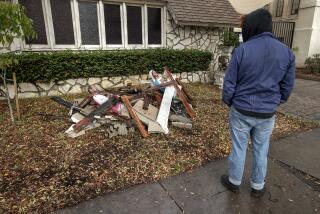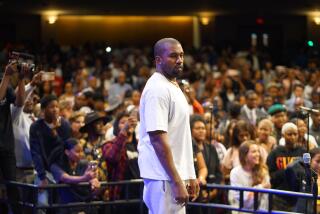Christian Cleric Argues That Jesus Was Black : Images: He says the popular notion of a white Christ is a myth. On Easter, he plans to ask his church members to burn those pictures and replace them with ones showing an Afro-Semitic.
- Share via
Was Jesus black?
Throughout the history of Christianity, believers have cast saints in their own cultural images.
St. Augustine, St. Monica and St. Cyril of Alexandria are believed to have been important blacks in the Roman Catholic Church.
Mary, the mother of Jesus, has been pictured as Anglo-Saxon, Latino, Asian and black. Until recently, however, Jesus has remained decidedly Caucasian in the minds of Christians of all races.
Now, a black Christian clergyman is not only picturing Jesus as black, but arguing that the blue-eyed, fair-skinned Jesus popularized by sacred art and Hollywood alike is a myth.
“Jesus Christ was Afro-Semitic--a black man,” said Archbishop George Augustus Stallings Jr., founder of the Imani Temples of the African American Catholic Congregation.
On Easter, Stallings plans to ask his church members to burn their pictures of white Jesus and replace them with black Christs.
Stallings, a former Roman Catholic priest who broke with the church in 1990 to form his own denomination, is in Los Angeles for a three-day “Black Christ/Black Church Project.” The conference began Friday and ends Sunday at Los Angeles Southwest College’s campus center, 1600 Imperial Blvd., South Los Angeles.
The purpose, Stallings said, is to “disseminate information on the true identity of Jesus Christ and to correct misinformation in literature and in the portraiture of Jesus with European features, with straight hair and thin lips.”
Stallings is the first to admit that the idea did not originate with him. In 1894, Bishop Henry McNeal Turner of the African Methodist Episcopal Church said that God is a “Negro.”
Jesus’ historical identity, Stallings said in a welcome letter to conference participants, has “remained shrouded in distortion and deception” despite gains made by blacks in other aspects of church life.
William E. Marshall Jr., Stallings’ spokesman, said in a telephone interview that the archbishop’s efforts have met with resistance, even in black churches. “They’ve been kind of nervous about it because you’re dealing with a religious icon, a very sacred image,” said Marshall. “To tell them this (white Jesus) is historically inaccurate would be to go in to say you’ve built a whole church around a racist icon. It sets an alarm off.”
He also said the proposal to burn white images of Jesus has encountered heavy criticism from participants at black Jesus conferences in other cities.
Marshall noted that many people ask what difference it makes whether Jesus was white or black. Spiritually speaking, it makes no difference, he said. “The Jesus of spirit is whatever color you want to be,” he said.
But there are political, historical and, Marshall said, theological implications.
“It makes a hell of a lot of difference if you’re going to have a man of color in your church on Sunday morning,” said Marshall. “It’s going to make you look at black people differently on Monday morning.”
More to Read
Sign up for Essential California
The most important California stories and recommendations in your inbox every morning.
You may occasionally receive promotional content from the Los Angeles Times.










